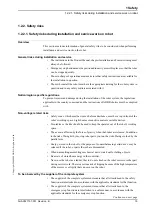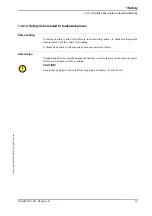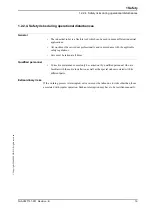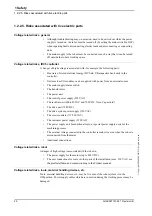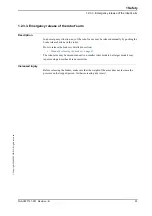
1 Safety
1.2.2.1. Safety risks during installation and service work on robot
15
3HAC027151-001 Revision: B
©
Co
py
rig
h
t 200
6-
200
8 ABB. All righ
ts reser
v
ed.
1.2.2. Safety risks
1.2.2.1. Safety risks during installation and service work on robot
Overview
This section includes information of general safety risks to be considered when performing
installation and service work on the robot.
General risks during installation and service
•
The instructions in the Product Manual, chapter Installation and Commissioning must
always be followed.
•
Emergency stop buttons must be positioned in easily accessible places so that the robot
can be stopped quickly.
•
Those in charge of operations must make sure that safety instructions are available for
the installation in question.
•
Those who install the robot must have the appropriate training for the robot system in
question and in any safety matters associated with it.
Nation/region specific regulations
To prevent injuries and damage during the installation of the robot system, the regulations
applicable in the country concerned and the instructions of ABB Robotics must be complied
with.
Non-voltage related risks
•
Safety zones, which must be crossed before admittance, must be set up in front of the
robot's working space. Light beams or sensitive mats are suitable devices.
•
Turntables or the like should be used to keep the operator out of the robot's working
space.
•
The axes are affected by the force of gravity when the brakes are released. In addition
to the risk of being hit by moving robot parts, you run the risk of being crushed by the
parallel arm.
•
Energy, stored in the robot for the purpose of counterbalancing certain axes, may be
released if the robot, or parts thereof, are dismantled.
•
When dismantling/assembling mechanical units, watch out for falling objects.
•
Be aware of stored heat energy in the controller.
•
Never use the robot as a ladder, that is, do not climb on the robot motors or other part
during service work. There is a serious risk of slipping because of the high temperature
of the motors or oil spills that can occur on the robot.
To be observed by the supplier of the complete system
•
The supplier of the complete system must ensure that all circuits used in the safety
function are interlocked in accordance with the applicable standards for that function.
•
The supplier of the complete system must ensure that all circuits used in the
emergency stop function are interlocked in a safe manner, in accordance with the
applicable standards for the emergency stop function.
Continues on next page















